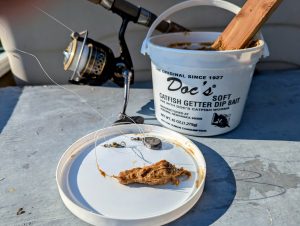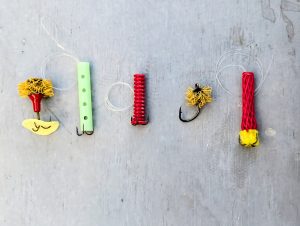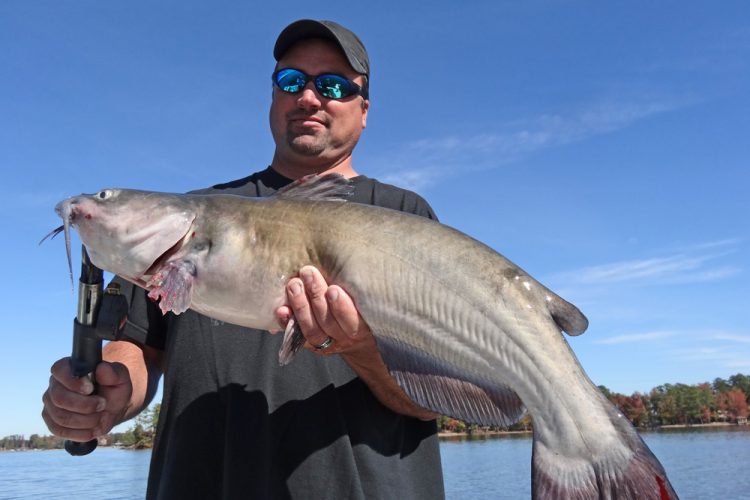Professional guide Chris Simpson has used stinkbaits effectively for many years on multiple lakes.
Stinkbaits for Channel Catfish
Story and photos by Terry Madewell
Channel catfish can be caught on a variety of baits, but stinkbaits are highly productive, providing fast-paced action for these pugnacious catfish.
The first time I dipped a gob of stinkbait goo on a small, deep-ribbed plastic worm, I looked over my shoulder to ensure no one was watching. I grew up catfishing with my Papaw, and he taught that catfish will chew on a wide range of potential foods sources. We experimented with some offbeat concoctions.

I had never seen anyone use a brown, smelly, goo, but after reading a catfishing story in a reputable magazine 50 years ago proclaiming stinkbait caught channel catfish like crazy, I was all in.
At the outset that day, the smell of the Doc’s Catfish Dip Bait was repugnant to my olfactory sense, and that’s being kind. By the end of that trip, a mere three hours later, I had that goo embedded under my fingernails, caked on my shirt and pants, and some ended up in my hair as I cast too hurriedly. In this brief time, I morphed from being ultra-careful with the baiting process to loading up a rig with reckless abandon to get it back in the water.
Because, after a mere 10 minutes, I knew that I was going to get my string stretched immediately by a channel catfish. I was shocked how well it produced.
I’d anchored on the ledge of the Cumberland River channel about mid-way up Old Hickory Lake near Nashville, Tennessee. My target was the junction of a ditch cutting through a shallow flat and merged with the river channel. The spot was a summertime white bass hole, and I selected it because I’d caught a few channel catfish on Rooster Tails while targeting white bass there.
I planned to cast multiple rigs to explore a large area but only had four positioned around the junction before the action began. While fighting that first catfish, two more rigs loaded up. I swung the first fish into the boat, and, as I grabbed the second rig, the fourth rod horseshoed.
I never got a second rod baited again that day.
Three hours of frantic, fish-catching action later, I was using my index finger to scrape the round corners of the bottom of the stinkbait tub, gathering the last of this precious, smelly concoction. The timing was ok because I had no cooler space available to wedge in another channel catfish.
I became a stinkbait believer that day and have used it often in the half-century since. The stinky goo has withstood my test of time. For a while, I tried to prove that this wild action was a fluke, but failing in that, I accepted its productivity as catfishing gospel. Since then, when I take kids or newcomers and want rods bent often, I’m a stinkbait guy.

The core rules of catfishing apply when fishing stinkbaits. Anglers must locate where catfish congregate. Often that’s around areas with underwater topographic changes. Points are prime targets whether near-shore or offshore. Channel ledges, creek and river junctions, and shallow humps near deep water all produce. Lake maps and electronics help pinpoint potential catfish hotpots.
Channel catfish often cluster around a specific target, ideal for an anchor-fishing setup. Drifting can be effective but requires extensive bait monitoring when bites are infrequent, because the stinkbait washes off. I prefer to anchor.
I’ll begin casting rigs to different depths around the target to locate the sweet spot. Plus, this sweet spot may change while fishing. I’ve found channel catfish in deep water and, while fishing, the catfish moved shallower to feed for a while before retreating again to deeper water. If action slows, it’s probably not the stinkbait that’s failing. It’s that fish are moving. Pay attention to where the bites occur, and cast a couple rigs to test different depths or areas.
The rigs for using dip baits vary. Multiple commercially prepared rigs exist, including deep-ribbed plastic worms with treble hooks. Also popular are round, hollow plastic sleeves with holes punched through the sides. These hold the bait while allowing scent to disperse and are quite popular.
A tactic that works for me is using a chunk of peeled shrimp threaded on a long-shanked single hook and dipped in the stinky goo. This ranks high on my personal options because if the goo washes off, the shrimp is still working for me, and it retains the “stink.”
Anglers can purchase sponges, or porous pool noodles, and customize their own stinkbait rigs. A piece of sponge soaked in stinkbait with a long-shank single hook works fine as a simple, inexpensive example.

The specific brand of stinkbait is a personal choice. Many varieties are marketed. They come in assorted flavors with cheese, blood, garlic and liver being common options. I’ve used multiple brands with success. I suggest testing multiple small tubs at first to determine what works best for your lake or river before buying the larger tubs.
Stinkbaits aren’t just for beginners. Pros use them, too, including catfish guide Chris Simpson (864-992-2352) who trusts this bait to produce channel catfish on guide trips. He uses other baits, too, but the reliability of stinkbaits makes it a first-team choice for him. Simpson appreciates that stinkbaits also tempt blue catfish.
As for putting the bait on your stinkbait-carrying vessel of choice, I recommend getting a wooden dipstick. Place the stinkbait holder in the goo, and use the dipstick to poke and cover it. Lift the line at an angle to take it out, ensuring maximum bait coverage. Before casting, hold the bait in the water for five seconds. It will set and is much easier to cast without raining stinky goo on the boat and other anglers. Trust me, you don’t want it in your hair.
Newcomers to stinkbait fishing typically begin using significant care to avoid it touching their body or clothes because it clings and stinks. But when fishing the right area, odds are high the ensuing catfish action will cause you to amend your cautionary baiting procedure, and by trips’ end, you’ll smell as one with the bait. That’s ok when you consider the fish-catching results.
I’ve learned it eventually wears off.
(Terry Madewell of Ridgeway, S.C. has been an outdoor communicator for nearly 50 years. He holds a degree in Wildlife and Fisheries Management and has a long career as a professional wildlife biologist/natural resources manager. He’s passionate about sharing outdoor adventures with others.)



